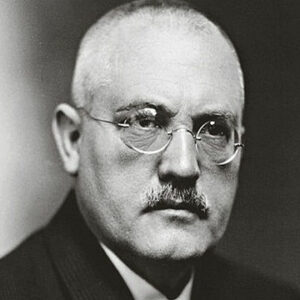Carl Bosch was a famous German industrialist and chemist. He is known for making the Haber-Bosch process for making ammonia under high pressure. For this, he won the Nobel Prize in Chemistry. As a chemist for a big German company, he turned a lab demonstration project into a large-scale, real-world operation. When Fritz Haber went to the company where Bosch used to work, BASF, he was given the job of making Haber’s idea of making ammonia for commercial use happen. Bosch was able to easily provide the raw materials and catalysts that were needed. The hardest thing for him to do was make equipment that could handle both the high pressures needed to make ammonia and the acidic effects of hydrogen gas. He did this by putting alloyed steel in place of Haber’s carbon steel reactor. It made possible Fritz Haber’s method of making ammonia, which is one of the most important industrial processes of the 20th century. He also made fuels like methanol and gasoline from coal and oil as part of his other work. Carl Bosch was also one of the people who started IG Farben, which is now one of the biggest chemical companies in the world. He and Fritz Haber were chosen by readers of TCE Magazine as “The Most Popular Chemical Engineers Ever.” Bosch also knew a lot about astronomy and had a private observatory that was well made.
Early years and childhood
Carl Bosch was born in Cologne, Germany, on August 27, 1874. His father was a person who sold gas and plumbing.
Robert Bosch, his uncle, was a famous engineer and inventor who made the first high-voltage spark plug that could be sold.
After high school, Bosch worked for a short time as a metal worker in a machine shop.
Between 1894 and 1896, he went to the Technische Hochschule in Charlottenburg to study metallurgy and mechanical engineering.
In 1896, he went to Leipzig University to study chemistry. In 1898, he graduated with a paper on organic chemistry written under Professor Wislicenus.
Carl Bosch’s Career
In April 1899, he started working as a chemist at BASF (Badische Anilin- und Soda Fabrik), Ludwigshafen, Rhine, which was the biggest chemical and dye company in Germany at the time.
Dr. Rudolf Knietsch was in charge of the company where he worked, and he worked hard to help the synthetic indigo industry grow.
He tried to figure out how to fix nitrogen by using metal cyanides and nitrides. In 1907, he started a pilot plant to make barium cyanide.
In 1908, Carl Bosch started a big project to figure out how to make ammonia in a factory setting. By 1913, the project was a success, and Stickstoffwerke, the first Haber-Bosch plant, was opened in Oppa.
In 1917, he opened another plant called Leunawerke near Merseburg, where he made methanol and hydrogenated oil as part of the production plan.
Bosch was put in charge of running the Badische Anilin- and Sodafabrik in 1919.
In 1925, he became the first head of the company I.G. Farbenindustrie Aktiengesellschaft, which was made when the German coal-tar dye works joined together.
In 1935, he was chosen to be the head of the I.G. Farbenindustrie A.G. board of directors.
He was made President of the Kaiser Wilhelm Society in 1937.
Works of note
Carl Bosch’s most important contribution was to turn the lab process for making ammonia into a commercial process. He put pure iron in place of osmium and uranium, which were Haber’s catalysts, and built safe, high-pressure blast furnaces to make the synthesis.
He came up with the way that steam and water are passed over a catalyst at high temperatures to make hydrogen on an industrial scale. The Haber-Bosch process is now the most common commercial way to fix nitrogen. It has helped increase agricultural production all over the world by making fertilizers available. It also had something to do with the Green Revolution.
Awards & Achievements
He received honorary doctorate from various institutes like Technische Hochschule in Karlsruhe (1918), the Landwirtschaftliche Hochschule (Agriculture College), Berlin (1921), the Technische Hochschule in Munich (1922), Halle University (1927), the Technische Hochschule in Darmstadt (1928).
He was named an Honorary Senator by Heidelberg University in 1922 and by Leipzig University in 1939. Frankfurt also named him an Honorary Citizen (1939).
Bosch got the Liebig Memorial Medal from the Association of German Chemists, the Bunsen Medal from the German Bunsen Society, the Siemens Ring, and the Golden Grashof Memorial Medal from the VDI.
He was also given the Carl Lueg Memorial Medal and the Exner medal by the Austrian Trade Association.
In 1931, he and Friedrich Bergius won the Nobel Prize for Chemistry, which is the highest international honor, for coming up with and developing chemical high-pressure methods.
Personal History and Legacies
He married Else Schilback in 1902, and the two of them had a son and a daughter.
Bosch loved to collect butterflies, beetles, minerals, and gems with all his heart.
Meteorites and other rocks that he had collected were given to Yale University. The Smithsonian Museum bought them in the end.
Carl Bosch’s name was given to the asteroid 7414 Bosch.
Bosch had always been against the policies of the Nazis. This is why, after Adolf Hitler came to power, he was slowly removed from his high positions.
He was sad and used too much alcohol. On April 26, 1940, in Heidelberg, Germany, he gave up and died.
Estimated Net worth
Carl Bosch’s estimated net worth is $9 million, and his main sources of income are from being an inventor, professor, engineer, and chemist. We don’t know enough about Carl Bosch’s cars or his way of life.


